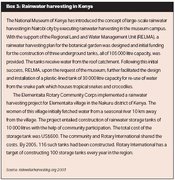Endowment opportunities from rainwater in Africa
Contents
- 1 Introduction Atmospheric resources offer important opportunities for sustainable development and improving human well-being. Their sustainable management can contribute towards the realization of the Millennium Development Goals (MDGs) and meeting the MDG targets, as well as regional and national targets: Rainwater harvesting can increase access to safe and clean water;Effective rain-fed agriculture (Endowment opportunities from rainwater in Africa) can improve food security and thus reduce extreme hunger; * Harnessing renewable energy resources can power small-scale rural industries and improve income; * Developing national renewable energy resources can enhance reliability and lower costs of electricity to the productive sectors; * Harnessing solar energy can improve access to household lighting and power, and increase livelihood and educational opportunities; * Increasing participation in global businesses and the market sector can lead to improved income and enhance opportunity; and * Reducing air pollution can result in improved health and reduce child and maternal mortality levels.
- 2 Rainwater
- 3 Further Reading
Introduction Atmospheric resources offer important opportunities for sustainable development and improving human well-being. Their sustainable management can contribute towards the realization of the Millennium Development Goals (MDGs) and meeting the MDG targets, as well as regional and national targets: Rainwater harvesting can increase access to safe and clean water;Effective rain-fed agriculture (Endowment opportunities from rainwater in Africa) can improve food security and thus reduce extreme hunger; * Harnessing renewable energy resources can power small-scale rural industries and improve income; * Developing national renewable energy resources can enhance reliability and lower costs of electricity to the productive sectors; * Harnessing solar energy can improve access to household lighting and power, and increase livelihood and educational opportunities; * Increasing participation in global businesses and the market sector can lead to improved income and enhance opportunity; and * Reducing air pollution can result in improved health and reduce child and maternal mortality levels.
Improving scientific and technological capacity, including through partnerships with the global community, is an important strategy for harnessing the full potential of atmospheric resources. Information and knowledge are increasingly driving societies and economies. The success of future societies, businesses and economies will be determined by their abilities to generate, process and make use of knowledge. Thus, harnessing atmospheric resources for sustainable development demands that Africa invest in broadening and strengthening science and technology capacity. Adding value to natural resources requires the development of new materials, processes and products. Advances in materials and biotechnology are crucial for most renewable energy technologies. In the short-term, Africa will have to rely heavily on technology transfer, although in the medium- to long-term, developing indigenous technology will be essential.
Africa can promote innovations through the establishment of science parks. These will serve as seedbeds for new technology-based firms (NTBFs), which could contribute to poverty reduction in the medium- to long-term. In the short-term, African governments could enter into partnerships with scientists in the African diaspora to support research and development in Africa. This strategy will repatriate knowledge and skills to Africa and assist in mitigating the “brain drain”.
Investment in basic research is important for maximizing opportunities. International cooperation, including through establishing partnerships between developing countries, could offer crucial support and access to resources. Cooperation between South Africa, India and Brazil in nanotechnology development is one example for an effective research partnership. Investing in basic research is important, as noted by the International Energy Agency (IEA):
"Developing advanced technologies requires not only applied research and technology refinement, but also the innovation that stems from advances in basic science. Knowledge flowing from basic research is what will feed the development of new materials, bioprocesses, nanotechnologies, and other approaches that could reduce clean technology costs. It could also lead to new unforeseen technologies and novel approaches to providing energy services. Effective linkage between basic science and applied technology development will be important to ensure that these opportunities are opened up".
The availability of fossil fuel energy reserves underpins the wealth of African countries and their ability to invest in the development of renewable energy resources, such as hydropower and solar energy. Oil reserves are found mainly in Algeria, Angola, Chad, Gabon, Mauritania, Equatorial Guinea, Egypt, Nigeria, Libya and Sudan and have been an important factor in improved economic growth . Africa has just 5 percent of the world’s coal resources, and over 97 percent of this is found in South Africa, Mozambique, Zimbabwe and Botswana. Most of the natural gas reserves are found in Western Africa (Nigeria 30.8 percent) and Northern Africa (Egypt 10.7 percent, Algeria 39.6 percent, and Libya 11.5 percent). Countries not endowed with fossil fuel reserves require substantial financial support to develop their atmospheric resources.
Rainwater
 Figure 1: Boy drinking water from a banana leaf, Nigeria.
Figure 1: Boy drinking water from a banana leaf, Nigeria.(Source: I. Uwanaka/UNEP/Still Pictures)
Relatively few African countries have an average annual rainfall exceeding 1,000 mm. More countries receive an average annual rainfall below 500 mm, and are thus considered to be dry lands. However, despite a history of drought and floods, rainwater has the potential to supply safe water and enhance food security through effective rain-fed agriculture.
Rainwater harvesting
 Figure 2: Rainwater harvesting in Kenya
Figure 2: Rainwater harvesting in Kenya(Source: rainwaterharvesting.org 2003)
Collecting rainwater for drinking, livestock and domestic use is an established practice in Africa. However, traditional collection techniques have become inadequate due to population growth and reduced rainfall. New methods of rainwater harvesting are taking root in Africa; for example, roof catchment and collection in tanks are particularly popular. Plastic or concrete tanks are preferred over metal tanks, as the latter corrode.
Improving the effectiveness of rain-fed agriculture
With the use of appropriate technologies, rainwater could play a bigger role in irrigation and combating the effects of drought. However, appropriate technologies will need to be developed and or acquired, and widely disseminated.
There is growing acknowledgement of the value of rainwater harvesting in rural areas. In Kenya, for example, road runoff catchment, water and farm ponds, sand and sub-surface dams, and conservation tillage have been adopted to increase agricultural production. A nongovernmental organization, Practical Action's (Intermediate Technology Development Group) work in Darfur, western Sudan, is a further example of effective use of rain-fed agriculture. In Darfur, ITDG is supporting the construction of dams across gullies, crescent terraces, shallow wells and channels as appropriate technologies for rainwater harvesting.
Investment in research and development to produce new irrigation systems that use water effectively, particularly in ASAL, should be encouraged. Widespread adoption of low-cost tube irrigation can contribute to poverty alleviation and improve food security and protect against famine. It has, for example, been successfully used in eastern India.
Further Reading
- Barker, R., van Koppen, B. and Shah, T., 2000. A Global Perspective on Water Scarcity/Poverty: Achievements and Challenges for Water Resource Management. International Water Management Institute, Colombo.
- ECA, 2005. Economic Report on Africa 2005: Meeting the Challenges of Unemployment and Poverty in Africa. Economic Commission for Africa, Addis Ababa.
- EIA, 2003. 8.2 World Estimated Recoverable Coal. Energy Information Administration.
- IEA, 2004. Key World Energy Statistics 2004.
- rainwaterharvesting.org, Center for Science & Environment, 2003.
- UNEP, 2006. Africa Environment Outlook 2
| Disclaimer: This article is taken wholly from, or contains information that was originally published by, the United Nations Environment Programme. Topic editors and authors for the Encyclopedia of Earth may have edited its content or added new information. The use of information from the United Nations Environment Programme should not be construed as support for or endorsement by that organization for any new information added by EoE personnel, or for any editing of the original content. |